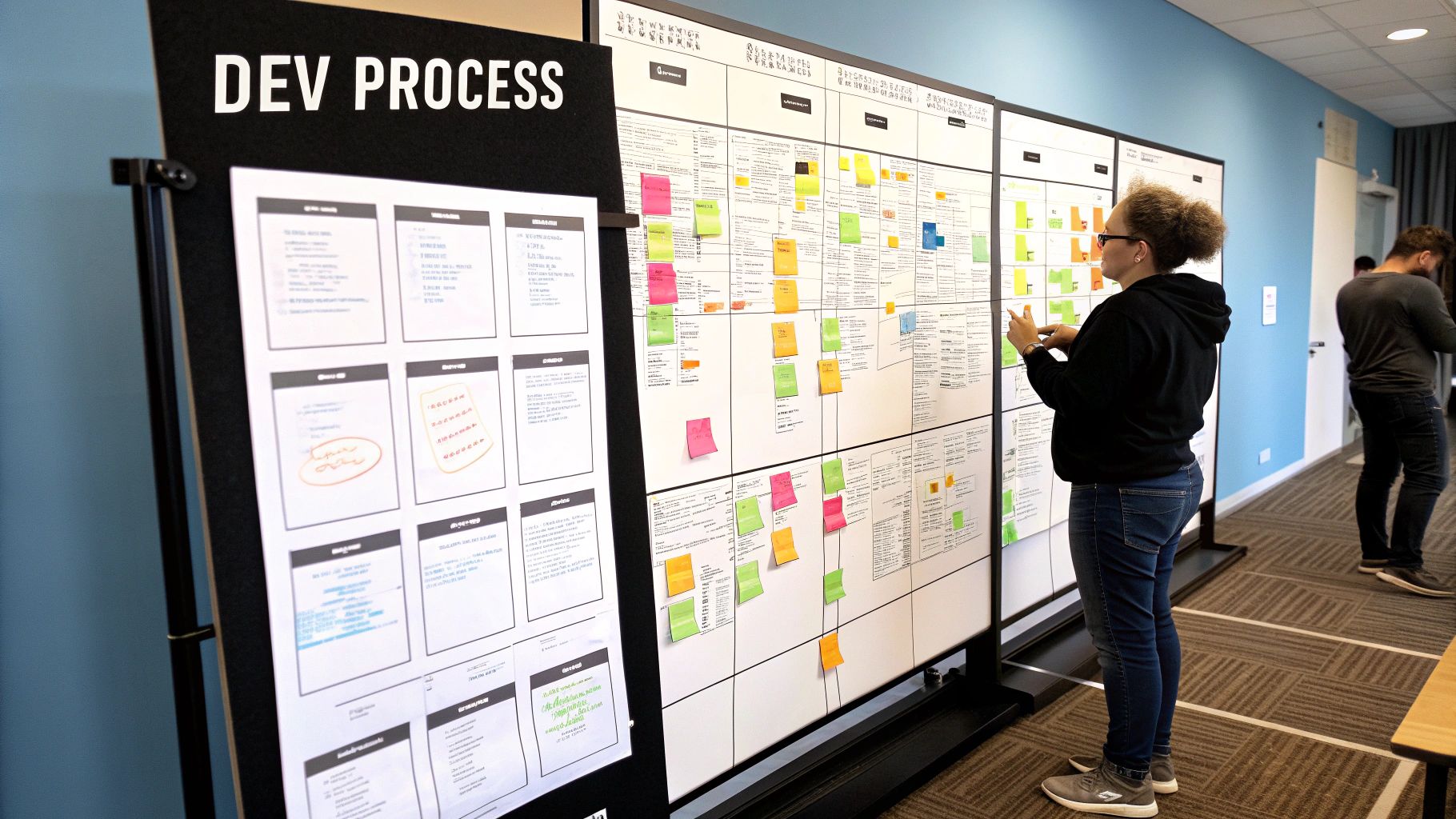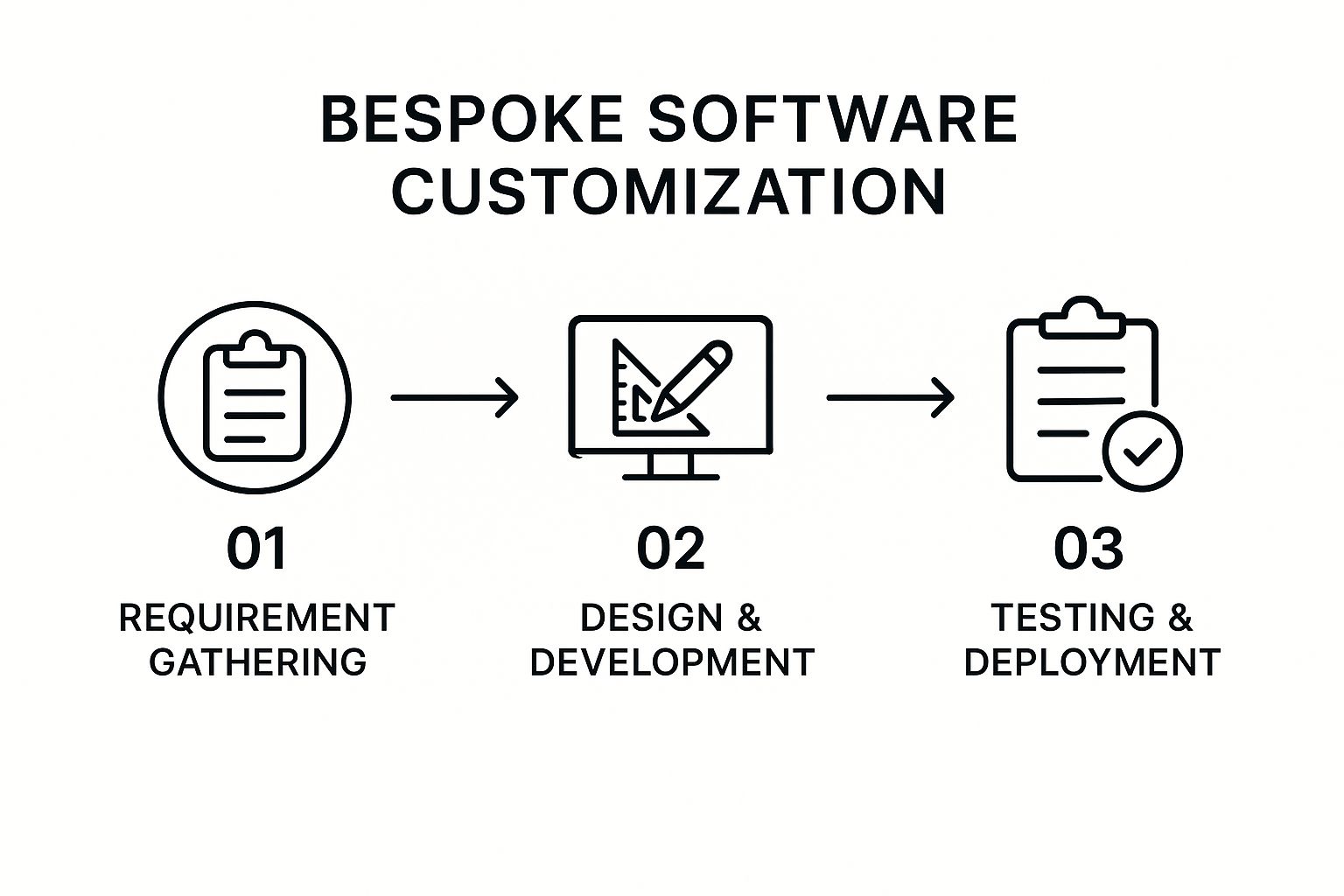The term bespoke software defines a software solution built from the ground up for a specific organisation’s precise needs. It stands in direct contrast to off-the-shelf products, which are designed as one-size-fits-all tools for a mass market. A bespoke system delivers functionality that is perfectly aligned with your unique operational workflows.
Unpacking the Concept of Bespoke Software

To illustrate the concept, consider the difference between purchasing a suit off the rack and commissioning a tailored one. The off-the-rack suit may be adequate for a single event, but it was designed for an "average" person, not for you. It might be restrictive in the shoulders or imprecise in its length, forcing you to compromise. This is analogous to off-the-shelf software; it provides a generic solution and expects your business to adapt its processes to fit the software's limitations.
Bespoke software, conversely, is the tailored suit. It is designed and engineered to your business’s exact measurements—your specific workflows, your daily operational challenges, and your long-term strategic goals. Every feature, interface element, and integration is included for a specific reason, implemented to support how your team actually performs its work.
The core principle is simple yet profoundly powerful: bespoke software adapts to your business, not the other way around. It delivers a precision-fit solution capable of solving complex problems that generic software cannot address.
Why Does This Distinction Matter?
Understanding the fundamental difference between custom-built and pre-packaged software is the first step toward making a more strategic technology investment. A common challenge for many businesses in the UK is hitting a growth ceiling imposed by their generic tools. They find themselves constrained by missing features, inefficient integrations, or the cumbersome workarounds their teams have been forced to develop.
Bespoke software removes these barriers. Instead of grappling with a tool that is almost right, you gain a system engineered from day one to:
- Solve Your Specific Problems: It is designed to overcome the unique operational hurdles that off-the-shelf software fundamentally ignores.
- Integrate Seamlessly: It connects flawlessly with the other mission-critical systems you already depend on, creating a fluid, unified digital environment.
- Deliver a Competitive Edge: It equips your business with capabilities that your competitors, who are likely using the same generic software, do not possess.
This approach elevates software from a mere utility into a genuine strategic asset. By moving beyond one-size-fits-all solutions, you can build a technological foundation that not only supports your business today but is architected to scale with you tomorrow.
For a deeper analysis of this topic, explore our complete guide on what is bespoke software development.
The Hallmarks of a True Bespoke Software Solution

What truly differentiates a bespoke software solution from its mass-market counterparts? The distinction goes beyond mere customisation. There are several core characteristics that define these systems, transforming them from an operational tool into a genuine strategic asset for your business.
At its core, bespoke software is about mirroring your business processes with high fidelity. It is built around your unique workflows, rather than forcing you to conform to its structure. This means every function, dashboard, and automated process is implemented to solve a specific problem or enhance a particular task for your team.
The most crucial hallmark is this: bespoke software adapts to your business, not the other way around. This fundamental principle is the key to unlocking tangible competitive advantages and moving beyond temporary fixes.
Functionality Built For Purpose
A well-architected custom solution is intentionally lean. It is free from the feature bloat that clutters many off-the-shelf products. Instead, it delivers the exact functionality your operations require, and this focused approach yields significant benefits:
- Precision Engineering: Every element is built to serve a specific purpose, eliminating interface clutter and accelerating user adoption.
- Process Automation: It is designed to automate your unique, and often complex, internal processes—tasks that generic software is ill-equipped to handle.
- Competitive Differentiation: You gain proprietary capabilities that competitors using mass-market tools cannot replicate.
This is not a niche trend; it is a strategic shift gaining significant momentum. With 70% of UK companies expecting higher turnover by 2025, many are turning to bespoke solutions to automate tasks, reduce errors, and optimise workflows. It is a strategic move that fuels growth by enabling personalised customer experiences and providing the precise data needed for informed, market-aware decisions.
Seamless Integration and Future-Proof Scalability
Another defining characteristic is its interoperability. A bespoke solution is engineered from the ground up to communicate flawlessly with the other critical systems you rely on, whether that is your CRM, ERP, or accounting software. This creates a single, unified digital ecosystem, eliminating data silos and the need for manual data entry between platforms.
Finally, any robust bespoke solution is designed with a long-term perspective. It is built for scalability, meaning it can adapt and expand in lockstep with your business growth. You can add new features, support more users, or handle increased data loads without being forced into a costly and disruptive migration to a new system. This foresight ensures your initial investment continues to deliver value for years to come.
To explore this further, read our article on the 5 advantages of bespoke software development.
Choosing Your Path: Bespoke vs Off-the-Shelf Software

Selecting the right software is a critical decision point for any business. It is not merely a technical choice; it is a strategic one that will shape your operational efficiency and capacity for growth for years to come. Rather than a simple list of pros and cons, let's examine this through a practical, real-world lens.
Consider a small but ambitious e-commerce business in its initial growth phase. An off-the-shelf platform like Shopify or BigCommerce is an excellent starting point. It is affordable, quick to deploy, and manages the core functionalities—product listings, payment processing, and shipping—allowing them to begin trading almost immediately. For that early stage, it is the appropriate tool.
However, let's fast-forward. The business is now scaling rapidly. It's managing inventory across multiple warehouses, coordinating a growing customer service team, and handling a complex returns process involving quality control and product refurbishment. Suddenly, the off-the-shelf platform begins to feel less like a launchpad and more like a constraint. Staff are forced into inefficient workarounds using spreadsheets and manual data entry, which inevitably leads to errors and operational delays.
When Off-the-Shelf Tools Hit a Wall
This scenario represents a classic growth challenge. It is the point at which the software that once enabled your growth begins to hinder it. The "one-size-fits-all" model cannot accommodate the specialised, complex requirements of a scaling enterprise.
This is precisely where understanding bespoke software becomes critical. It offers a different path forward—one you architect yourself to solve your unique, high-value problems. For our e-commerce company, a bespoke system could be designed to:
- Unify Warehouse Management: Automatically route orders to the most efficient warehouse based on stock levels and location.
- Streamline the Returns Process: Create a custom workflow for returns, with automated steps for inspection, customer communication, and restocking.
- Integrate Seamlessly: Connect inventory data directly with their accounting software and customer service hub, creating a single source of truth for the entire organisation.
The key distinction is not merely about features; it is about ownership and control. With off-the-shelf software, you are essentially leasing a solution. With bespoke software, you are building a valuable, proprietary asset.
Bespoke vs Off-the-Shelf Software At a Glance
To make an informed decision, you must look beyond the initial price. While off-the-shelf tools have a lower entry cost, ongoing subscription fees, charges for essential add-ons, and the cost of operational inefficiency can accumulate significantly. It is vital to consider the Total Cost of Ownership (TCO) to understand the true long-term financial impact.
This table outlines the key strategic differences to help you evaluate your options.
Ultimately, choosing the right path requires an honest assessment of where your business is today and, more importantly, your strategic objectives. For simple, standardised needs, an off-the-shelf solution is often the most pragmatic choice. But for any business with unique processes and significant growth ambitions, a bespoke solution is not just software—it is a strategic investment in your future.
How Bespoke Software Is Built: The Development Journey
Translating a business requirement into a fully functional, high-performance software application can seem complex, but it is a structured and transparent process. The development lifecycle is a true partnership, combining your deep business expertise with our technical leadership to ensure the final product delivers measurable results.
This methodical process is designed to turn a strategic vision into a tangible business asset.
Stage 1: Discovery and Strategy
Every successful project begins not with code, but with conversation. The Discovery and Strategy phase is arguably the most critical stage of the entire journey. This is where we collaborate with your key stakeholders to gain a deep understanding of your business—your objectives, your operational pain points, and the specific opportunities you aim to capture.
Our role is to immerse ourselves in your operational reality to define what success looks like in measurable terms. This involves:
- Mapping Workflows: We analyse your current processes to identify bottlenecks and pinpoint opportunities for automation and optimisation.
- Defining Objectives: We establish clear, quantifiable business outcomes. Are you aiming to reduce operational costs by 20% or decrease customer response times? These objectives guide the entire project.
- Technical Planning: We begin to architect the solution, selecting the appropriate technology stack and creating a strategic project roadmap.
This initial deep dive ensures complete alignment on the 'why' behind the software before any development work commences. It forms the solid foundation upon which everything else is built.
This infographic provides a simplified overview of the core stages involved in bringing bespoke software to life.

As you can see, the process is logical and sequential, moving from understanding the requirement to building and ultimately launching the solution.
Stage 2: Design and Prototyping
With a clear strategy established, we move into the Design and Prototyping phase. Here, your concept begins to take visual form. The focus is not just on aesthetics, but on crafting an intuitive and efficient user experience (UX) that makes the software effective and easy for your team to adopt.
We develop wireframes and interactive prototypes that serve as a functional blueprint for the final product. This allows you to click through screens, test user journeys, and provide critical feedback early in the process. It ensures the layout and navigation are perfectly aligned with your unique workflows.
This iterative design process is vital. It allows us to refine the user journey and make crucial adjustments before significant development resources are committed, saving considerable time and expense.
Stage 3: Development and Testing
This is where the approved designs are translated into a robust, working software application. Our development team builds the application in a series of manageable 'sprints', focusing on writing clean, efficient, and secure code. Throughout this Development and Testing phase, transparency is paramount.
We subject the software to rigorous testing at every stage, including:
- Unit Testing: Verifying that each individual component of the software functions correctly in isolation.
- Integration Testing: Ensuring that all the different parts of the software work together seamlessly.
- User Acceptance Testing (UAT): This is where your team gets hands-on, testing the software in a real-world context to confirm it meets all specified requirements.
Finally, the Deployment and Support phase marks the launch of your new software. However, our partnership does not end at deployment. We provide ongoing support and maintenance to ensure your bespoke system continues to perform optimally and evolves in line with your business needs.
Bespoke Software in Action Across UK Industries
While the theory is useful, understanding what is a bespoke software solution becomes clearer when examining its real-world application. These custom-built systems are not exclusively for large tech corporations; they are driving significant improvements across a diverse range of UK industries, solving high-stakes problems that generic software cannot address.
The true power of bespoke software lies in its ability to meet unique, industry-specific challenges head-on. These examples demonstrate how technology that is built for purpose delivers a tangible competitive advantage.
Driving Efficiency in UK Manufacturing and Logistics
Consider a medium-sized manufacturing firm in the Midlands struggling with an off-the-shelf logistics package that could not handle its complex supply chain. The consequence was frequent shipping errors and costly operational delays. By investing in a bespoke logistics platform, they created a system that precisely mirrored their workflow.
This new system automated inventory checks across multiple warehouses, calculated the most efficient delivery routes in real-time, and integrated directly with their suppliers' ordering systems. The results were both immediate and significant:
- Drastic Reduction in Errors: Shipping mistakes were reduced by over 90%, saving thousands in returned goods and redelivery costs.
- Improved Delivery Times: Automated route planning increased driver efficiency, improving on-time delivery rates and enhancing customer satisfaction.
- Complete Operational Visibility: Management gained a real-time dashboard displaying the entire supply chain, enabling smarter, data-driven decision-making.
This is not an isolated success story; it reflects a broader trend. The UK bespoke software development market is projected to grow at a compound annual growth rate of approximately 24.82% between 2025 and 2035. This growth is driven by businesses in sectors like manufacturing, retail, and finance abandoning one-size-fits-all tools in favour of applications designed for their specific operational needs. You can read more about these key market growth drivers.
Enhancing Security and Client Trust in Financial Services
Now, consider a financial advisory firm in London responsible for managing highly sensitive client data. Their existing client portal was functional but lacked the robust security and personalised experience their high-net-worth clients expected. They commissioned a bespoke, high-security client portal to address this.
The new platform was not just a piece of software; it became a cornerstone of their client relationship strategy. It provided bank-level encryption, multi-factor authentication, and a personalised dashboard where clients could view portfolio performance and communicate securely with their advisors.
This custom solution did more than enhance security; it transformed the client experience, building trust and significantly increasing client retention rates. By providing a secure and polished digital environment, the firm demonstrated a tangible commitment to protecting its clients' interests—a powerful differentiator in a competitive market. These examples make it clear: when software is built for a specific purpose, it becomes a powerful engine for growth and efficiency.
Understanding the Investment in Bespoke Software
That initial outlay funds a comprehensive process of discovery, design, and development tailored to your precise requirements. You are investing in a permanent business asset that you own outright, liberating your organisation from the perpetual cycle of recurring licence fees that can quietly erode your budget over time.
From Upfront Cost to Long-Term Value
A monthly subscription fee may seem manageable initially, but these costs accumulate significantly over the years, and are often subject to unexpected increases. Bespoke software, in contrast, typically results in a lower Total Cost of Ownership (TCO). Once built, it is yours. There are no surprise price hikes or forced upgrades that disrupt your operations.
The true return on this investment is realised through tangible business improvements. For example, automating a single, repetitive manual process can reclaim hundreds of staff hours annually, directly impacting your bottom line.
The real value of bespoke software is not measured by its initial price, but by the operational efficiencies it creates, the new capabilities it unlocks, and the sustainable competitive advantage it provides.
What Factors Influence the Investment?
The investment required for a custom solution is not a fixed figure. It is determined by several key factors that define the project's scope and complexity. Understanding these elements provides clarity on where the investment is allocated:
- Project Complexity: A simple internal tool for automating a single workflow will require a different level of investment compared to a complex enterprise platform managing an entire supply chain.
- Required Integrations: If the software must interface with existing systems—such as CRMs, ERPs, or third-party APIs—this will influence the development effort required.
- Unique Features: The number and sophistication of the features designed specifically for your business are the primary drivers of the overall investment.
The UK's software distribution market, which includes bespoke solutions, is forecast to reach approximately USD 22.1 billion in 2025. This growth signifies a clear trend: UK businesses are increasingly investing in tailored IT services to enhance efficiency and maintain a competitive edge. You can find out more about the software market trends in the United Kingdom. For a more detailed breakdown, you may find our guide on investing in bespoke software solutions to be of interest.
The Questions We Always Get Asked About Bespoke Software
When considering a custom software project, it is natural to have several important questions. Having guided numerous UK businesses through this journey, we have found that the same practical concerns consistently arise.
Here, we provide direct answers to the questions we encounter most frequently.
One of the first questions is, "How long will the project take?" The timeline is entirely dependent on the scope and complexity of the software being built. A simple internal utility might be developed and deployed within a few months. A large-scale, enterprise-level platform could take a year or more. This is why the initial discovery phase is so crucial—it allows us to establish a clear and realistic project roadmap from the outset.
Another common question relates to post-launch: "What happens once it's built?" A professional development partner does not simply deliver the software and disengage. We view it as an ongoing relationship. We provide continued maintenance and support to ensure your system remains secure, performs optimally, and evolves with your business.
Getting The Details Right
"How much of my team's time will be required?" Your input is absolutely critical, particularly during the initial discovery phase and later during user acceptance testing. As the expert on your business, your insights are what ensure the final product effectively solves your specific challenges. However, you do not need to be a technical expert; that is our role.
Finally, business leaders often ask, "Can we make changes or add features later?" Absolutely. This is one of the primary strengths of a bespoke approach. The software is architected from the ground up to be flexible and scalable. As your business evolves or market conditions shift, we can readily add new functionality or modify existing features.
A bespoke project is best understood as a partnership. It combines your deep industry knowledge with our technical expertise to build a true strategic asset for your business—one that delivers sustained value for years to come.
Ready to move beyond the limitations of off-the-shelf software? At Make IT Simple, we specialise in creating high-performance software that solves complex business problems and drives sustainable growth. Let's discuss turning your strategic vision into a reality. Book a no-obligation consultation today.


